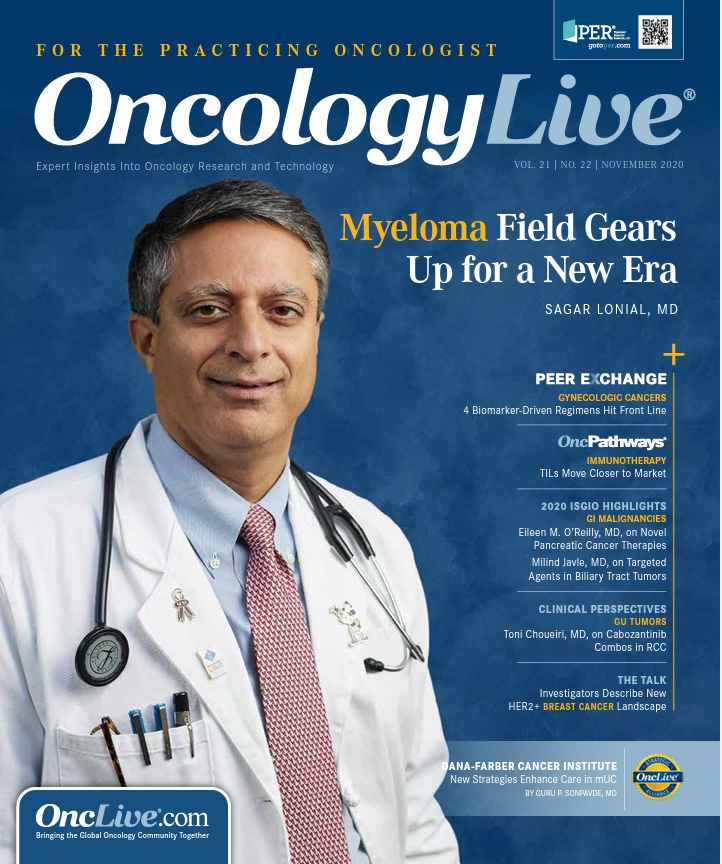Publication
Article
Oncology Live®
METex14+ NSCLC Armamentarium Welcomes First Targeted Therapy
Author(s):
The first biomarker-drive intervention for patients with non–small cell lung cancer whose tumors harbor a MET exon 14 skipping mutation is now available in clinical practice.
Edward B. Garon, MD, MS

The first biomarker-driven intervention for patients with non–small cell lung cancer (NSCLC) whose tumors harbor a MET exon 14 (METex14) skipping mutation is now available in clinical practice.
On May 6, 2020, the FDA granted an accelerated approval to capmatinib (Tabrecta) for adults who have metastatic NSCLC with a mutation that leads to METex14, as detected by an FDA-approved test. The agency concurrently approved Foundation Medicine’s FoundationOne CDx assay as a companion diagnostic for capmatinib.1
The approval of capmatinib for patients with METex14-mutant advanced NSCLC is based on overall response rate (ORR) and response duration data from the phase 2 GEOMETRY mono-1 trial (NCT02414139). The safety and efficacy of capmatinib were evaluated in a subpopulation of 97 patients, who received 400 mg of capmatinib twice daily.
Among the trial’s 28 treatment-naïve patients, the ORR was 68% (95% CI, 48%-84%), with a response duration of 12.6 months (95% CI, 5.5-25.3).1 In the 69 patients who received prior treatment, the ORR was 41% (95% CI, 29%-53%). The response duration in this subgroup was 9.7 months (95% CI, 5.5-13.0).2 Continued approval may be contingent on verification and clinical benefit observed in confirmatory trials.
Capmatinib is the first therapy specifically approved to target METex14 mutations in NSCLC,1 which have been observed in 3% to 4% of cases.3 The agent also was evaluated in patients with MET amplifications, which occur in 1% to 6% of NSCLCs, as part of GEOMETRY mono-1.
In patients with MET amplifications with a gene copy number of 10 or higher, the ORR was 29% (95% CI, 19%-41%) for those previously treated and 40% (95% CI, 16%-18%) for those without prior therapy. Efficacy was limited at lower expression levels.3
In an interview with OncLive®, Edward B. Garon, MD, an author on the GEOMETRY mono-1 trial and an associate professor of medicine in the Division of Hematology/Oncology at the David Geffen School of Medicine at the University of California, Los Angeles, discussed the therapy’s tolerability and its groundbreaking contribution to the NSCLC tool kit.
OncLive: Why is the approval of capmatinib meaningful for this molecularly specific patient subgroup?
Garon: Capmatinib is approved specifically for patients with MET exon 14 deletions [which can cause METex14 mutations3]. For decades, MET has been recognized as an oncogene with the potential to drive tumors.
Generally, patients with these deletions do not have particularly good prognoses, and this is also a population of patients that does not [respond well] to standard chemotherapy. Similarly, it is a group that does not tend to have great responses to immunotherapy [based on] available data.
This is not a particularly rare group of tumors. The patient population tends to be a little older than what is seen in other oncogene-driven tumors and is more similar to what we see in the general lung cancer population.
Please discuss the efficacy data that led to the approval.
The efficacy data for the approval was based on 2 cohorts of the GEOMETRY mono-1 study. One cohort [included] patients who received prior therapy; the other cohort, patients who were treatment naïve. In the prior chemotherapy group, the response rate was over 40%. The response rate was about two-thirds in patients who were treatment naïve. Both of these response rates would be better than what would be [possible] with standard therapy.
How well are patients able to tolerate capmatinib?
In general, capmatinib’s toxicity profile was quite good in the GEOMETRY mono-1 study. Patients were able to tolerate the drug well, and most did not require dose reduction. The dosing for capmatinib is 400 mg twice daily.
The most common toxicity with capmatinib is peripheral edema, and although in some cases it could be quite significant, in most cases it was grade 1 or grade 2. Overall, other toxicities have been less common.
How does this approval advance the paradigm?
This is the first agent that is approved for this population of patients, [and notably, it] is the first biomarker-directed therapy for these patients. This group would be eligible for other standard therapies, so prior to this approval, patients would probably be receiving combinations of chemoimmunotherapy, although the role of immunotherapy in this population is not entirely well known.
That would be the frontline [therapy]; second-line approaches would include docetaxel-based chemotherapies. For patients with METex14 skipping–mutant NSCLC, capmatinib would be a very appropriate [agent] to consider as part of initial therapy, as well as for patients who previously received other therapies and are now progressing on those therapies.
What are the next steps for this agent?
We still do not have much available data. The GEOMETRY mono-1 was a very large study that also looked at the role of capmatinib in patients who had amplification of the MET gene. I think evaluating the [agent] in that group of patients will be important. Combinations of capmatinib and other drugs that could enhance both the response rate and duration of response [will likely also be explored].
References
- FDA approves first targeted therapy to treat aggressive form of lung cancer. FDA. May 6, 2020. Accessed November 5, 2020. https://bit.ly/2GAmA1E
- Tabrecta. Prescribing information. Novartis; 2020. Accessed October 12, 2020. https://bit.ly/3l2rp2J
- Wolf J, Seto J, Han JY, et al; GEOMETRY mono-1 Investigators. N Engl J Med. 2020;383(10):944-957. doi:10.1056/NEJMoa2002787

























%20(2)%201-Recovered-Recovered-Recovered-Recovered-Recovered-Recovered-Recovered-Recovered-Recovered-Recovered-Recovered-Recovered-Recovered-Recovered-Recovered-Recovered-Recovered.jpg?fit=crop&auto=format)
%20(2)%201-Recovered-Recovered-Recovered-Recovered-Recovered-Recovered-Recovered-Recovered-Recovered-Recovered-Recovered-Recovered-Recovered-Recovered-Recovered-Recovered-Recovered.jpg?fit=crop&auto=format)
